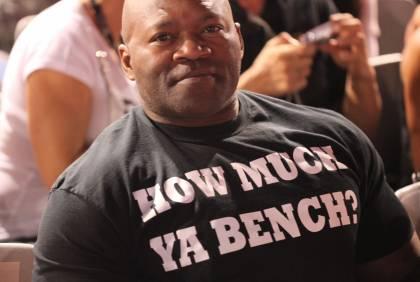Sports Medicine


Preventing Bench Press Injuries
QUESTION: How do I prevent injury while benching?
ANSWER: The bench press is one of the most common and highly-regarded exercises in the weight room. In fact, most individuals measure their strength by how much weight they can bench press. Weight trainers rarely ask each other how much they lift on the leg extension or tricep pushdown exercises. The question invariably is, "how much ya bench", causing many people to push the training envelope in an effort to increase their bench numbers, resulting in injury. The most common mistake is benching too often, which does not allow the muscles and ligaments to heal properly. With this overtraining syndrome, many areas of the shoulder are affected which can cause injury and decrease your overall performance.
One of the best ways to prevent injury when benching is through consistent employment of excellent technique. Proper technique can be summarized in one word - CONTROL. When bench pressing, it is extremely important that the weight is controlled by the lifter for the duration of the repetition. If the bar is descended too quickly, it can hit the chest in the wrong spot, causing improper ascension towards the abdominals, resulting in compensation by raising the hips. This automatically forces the bar to go back over the chest, improving the chances of completing the lift. The correct way to do the bench press is to lower the weight to the chest in a controlled motion. Note that the motion is described as controlled, not slow. The bar can still descend at a rapid pace, but at a controlled rapid pace. Too much energy may be expended if the descent time is too long. However, for beginners, a slower pace is preferable over one that is too fast. Once the ability to control the lift at a slow speed is mastered, the speed can be increased. One of the best cues to learn how to maintain control is in grip strength. The harder the bar is squeezed, the more control is gained over the bar. Visualize making dents in the bar with your fingers and the bar will become easier to control. For this reason, the false or “thumbless” grip is not recommended, (whereby the thumb is positioned on the same side as the fingers). Research has shown that bench numbers can be increased by up to 10%, simply by improving grip strength. In addition, the thumbless grip increases the potential for injury. The bar can slip or flip out of your hands and land on your chest, marring your training program. Secondly, there is no rational reason to use the thumbless grip. Some individuals contend that it makes the exercise “stricter”, an incorrect assumption. This grip only increases the potential for the bar to flip out of the hands. The preferable alternative is to use a full grip and a stricter technique, which will allow an increase in the amount of weight lifted. The thumbless grip also increases the likelihood of a wrist injury, as the wrist is kept hyperextended (wrist bent backwards) to allow the bar to rest in the palms of the hands. With enough weight and time, an injury to the wrist is created.
The second area of discussion involves the relationship between elbow angle and body position. The question is whether the arms should be held close to the body or at 90 degrees from the body. The answer is dependent on the motivation for doing the bench press in the first place. If the goal is to increase bench press poundage, keep the arms closer to the body, usually at a 45 degree angle. This technique allows a backward push at the very bottom of the bench press and utilizes the anterior deltoids, along with the chest. If muscular development of the chest is the objective, then benching with the arms out at 90 degrees from the body will put more stress on the pectorals and ,therefore, increase chest development. In summary, to increase strength bench at 45 degrees, to increase the chest muscles, bench at 90 degrees. Furthermore, varying the angle throughout your training cycle will achieve different effects.
Dr. Ken Kinakin is a Chiropractor and a Certified Strength and Conditioning Specialist. He is the founder of the “Society of Weight-Training Injury Specialists” – SWIS and can be reached at www.swis.ca.

